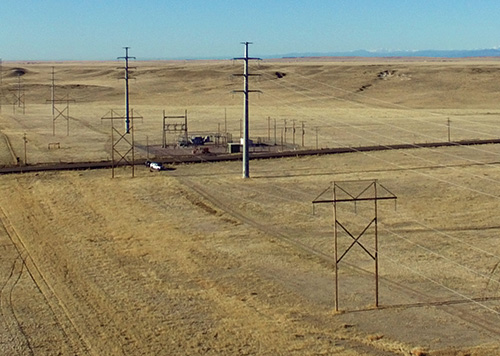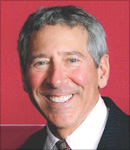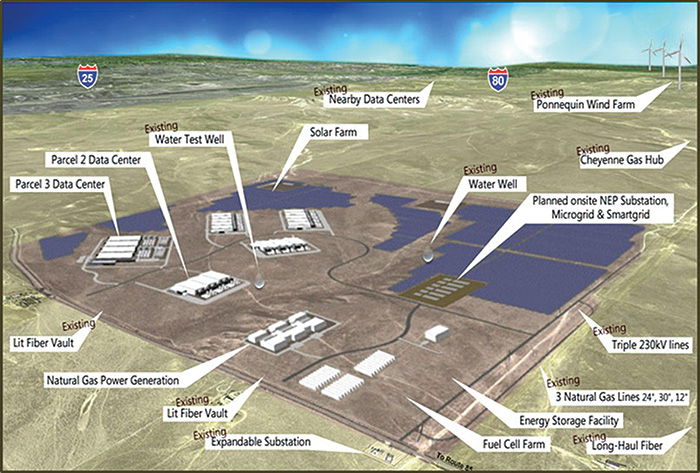Five years ago, Rawah Resources secured a square mile of prairie north of Denver, Colorado. At the time, we couldn't fully foresee what it would become, but after a number of twists and turns, we've finally shovel-readied the industrial site called the Niobrara Energy Park (NEP). According to Forbes, it's the world's largest planned microgrid.
When, in the summer of 2010, 662 greenfield acres was acquired, we knew we had an industrial park site with exceptional hybrid-energy potential. We also knew we needed more information so we strategically researched the site's highest and best use.
We turned to one of the 20 specialty consultants we regularly rely on for their niche expertise and ordered a due-diligence study on the high-voltage electric. It turned out that a new, $40-million transmission grid, owned by Tri State and Western Area Power Administration (WAPA), ran over the property, quadrupling the power capacity from a single 150kV to double 230kV. A mere 18 miles downstream from the project on the existing three 230 kV transmission lines is the largest electrical trading hub in Colorado, the Ault substation. That was the first happy surprise.
The second bit of good fortune came when the next due-diligence study revealed that one of the three largest natural-gas trading hubs in the U.S., with over 50 sellers of gas in any given hour, was a stone's throw away, providing a close source for the lowest-cost natural gas in America. Later in the project timeline, we would also take the inventive step of applying for and securing the first Colorado PUC investor-owned gas utility in 17 years, clearing the way for both natural gas supply distribution and a supply pipeline from the hub. At the same time, access to three in-project major gas transmission lines for use in the industrial park already existed, with 1.5 billion cubic feet of daily gas capacity. One of these lines cost $300 million and was built just five years earlier.
In addition to bountiful electrical and natural gas supplies, the site enjoys ample sunshine as well as wind - as attested to by the three regional wind farms located nearby - not to mention abundant fiber from over 21 providers and large volumes of clean, cool industrial water. We showed the project to experts at the Colorado School of Mines, and they told us we might have created the first hybrid energy park in America.
After compiling the by-now extensive site research, we applied for the first all-industrial/commercial PUD zoning in Weld County and we leveraged the research to achieve innovative zoning. In 2011, the Weld County Commissioners granted the project future-proof zoning' for 52 approved energy, manufacturing, and data land uses (some of which haven't been invented yet), along with a multitude of permissions, including environmental waivers on natural gas power plants, a substation of any size, high-transmission lines of any size within the project boundaries, and even energy storage. Very few properties in the county are zoned for both energy generation and energy consumption, much less 650 megawatts (MW) of natural gas and 50 MW of solar.
The time is ripe for an energy site with this confluence of attributes. According to Tony Georgis of NewGen Strategies & Solutions, clean energy is increasingly paramount. The Energy Information Administration (EIA) projects that almost 90 percent of all new power generation constructed in the U.S by 2020 will be either natural gas-fired or renewable. This equates to 26 gigawatts (GW) in new natural gas capacity and 18 GW of new renewable capacity in the next five years. This added renewable and natural gas power capacity addresses the growth of the power system while replacing the nearly 30 GW of projected coal generation plant retirements. Xcel Energy's recent decision to not renew 250 MW of coal-fired power supply from the Laramie River Generating Station in Wyoming further illustrates the decline of coal-fired generation in Colorado and the U.S. The near term linkage between natural gas and renewable power generation growth will continue, as natural gas is one of the few options to replace base-load power and integrate the large amounts of renewable energy to be constructed on the national power grid and the Western U.S. in the next five to 10 years.
What's more, the site's double energy market potential makes it more than a microgrid. Existing transmission lines running through the site provide additional flexibility for serving NEP's own power needs as well as renewable/excess power generation sales to Colorado or Wyoming utilities. A study completed by Exponential Engineering estimates that an adjoining transmission substation can be expanded to provide 30 MW of near-term export or capacity needs at NEP while local generation is constructed. This provides the potential for a bridge to constructing utility-scale renewables, a micro-grid, and conventional power generation. The same study identified transmission capacity at NEP to export up to 200MW of capacity south to the Denver metro area or north to loads in Cheyenne and the Colorado / Wyoming border area.

In addition to the Denver-metro energy needs, the Niobrara-Codell shale gas production power needs continue to grow near the NEP site, with oil resources estimated as high as 2 billion barrels of oil. Public Service Company of Colorado (PSCo or Xcel) is currently evaluating the area and opportunity to expand its transmission service to serve the large power and energy loads associated with shale gas and oil production and delivery operations in the area. This electric transmission expansion could also benefit NEP with added opportunities to export power (above and beyond the existing 200 MW) from NEP to the Denver-metro or shale gas production areas.
Niobrara Energy Park's platting was completed in February of 2015. The site is 100-percent de-risked and ready for the buyer who hoists the best, brightest shovel. Not only do we have a lot of time and capital invested in this site, we have a strong commitment to seeing it succeed. So does Cushman & Wakefield and its 15,000 global professionals now representing the sale of the site. Jeff Cushman said, "Niobrara Energy Park represents a unique opportunity to acquire a strategically located, shovel-ready site with extraordinary energy and fiber infrastructure along with entitlements and zoning for a broad range of industrial and energy related development. It offers multiple revenue pathways for an investor along with speed to market. There is nothing else like it in the country."
In fact, NEP epitomizes the socioeconomic paradigm shift we are currently experiencing, what economist and author Jeremy Rifkin calls the Third Industrial Revolution.' According to Rifkin, the Internet and renewables are merging to create integrated, interactive, and seamless energy and information networks. The future is rife with possibility, and NEP is a shovel-ready field of dreams for the investor, developer, and/or end user with vision.
About the Author
 Craig Harrison has been a Colorado commercial land and water-rights innovator for nearly 40 years. He is also a rancher and founder of Niobrara Energy Park (www.niobraraenergypark.com). He invites interested parties to contact him at 970-612-4100 or craig@harrisonresource.com and to visit the project online at www.niobraraenergypark.com
Craig Harrison has been a Colorado commercial land and water-rights innovator for nearly 40 years. He is also a rancher and founder of Niobrara Energy Park (www.niobraraenergypark.com). He invites interested parties to contact him at 970-612-4100 or craig@harrisonresource.com and to visit the project online at www.niobraraenergypark.com








